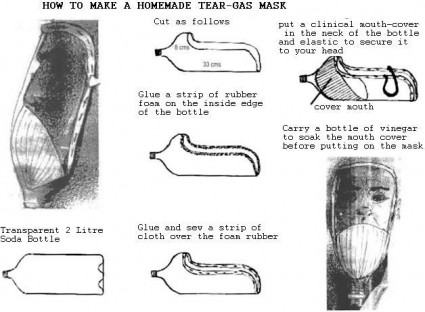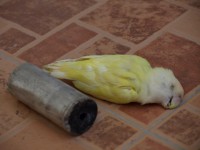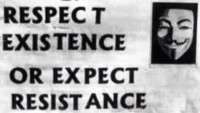DIY Personal Protection from Tear Gas

The mask could be easily adapted for emergency in home use, especially for at risk individuals – infants, elderly and those with repository or heart conditions or disease. The air nozzle (cap outlet) could be fashioned with an additional filter that could be exchanged more frequency (vinegar soaked sock + elastic band). This design could be very useful when gas is penetrating into the house during a “saturation bombing”.
The first thing to remember about tear gas is that it is primarily a fear weapon. Yes, the gas hurts. But the fear caused by tear gas grenades is a much more effective means of crowd dispersal than the gas itself. So rule number one is to calm down. Tear gas is most often delivered to its target in the form of grenades. These fit onto the end of gas guns and are fired with blank shotgun cartridges. So, when tear gas is being used you will hear gunshots. Look around make sure they are only firing tear gas a not bird shot as well, then look up. The grenade will be arcing toward its destination trailing white smoke. If the grenade is not headed directly at you, there is no reason to move. So don’t move just yet. Warn people that there is a grenade incoming, and figure out where it will land. If it is headed toward you, you may want to prepare to hold your breath and then as calmly as possible get out of the way of the exploding grenade. The grenade is supposed to explode in the air, but it does not always. After the explosion, a small gas emitter remains. It is metal and about the size of a hockey puck. It will be hissing and spewing out tear gas.
The wind is your friend. Move upwind of the gas. This will blow the majority of the gas away from you. Do not panic. Do not run. Panic is precisely what the police are trying to create. If you have gloves and something to protect your face, you can pick up the gas emitter and lob it back at the police. This is a considerate thing to do to protect your fellow protesters. The emitter will be hot, so gloves are recommended.
WARNING: Picking up the gas emitter will ensure that your clothing is saturated with tear gas. This is extremely unpleasant and will require very thorough laundering with
harsh detergent. Prevent contact between gassy clothes and your face, as the chemical agents are active even days later. WARNING: Do not pick up a grenade which has not exploded. You can be injured if/when it goes off in your hand. Some are, of course, duds. But it is not safe to assume that unexploded grenade at your feet is a dud.
Assuming you don’t have a gas mask (which is essential for prolonged operation in a tear‐gassy environment), a bandanna or other cloth which has been soaked in vinegar or
lemon juice will allow you to breathe long enough to escape the gas. Mask up! Cider vinegar is less harsh‐smelling and is recommended. Breathing in vinegar is not pleasant, but compared to tear gas it’s like fresh air. Unfortunately, the vinegar’s protective effect does not last long (minutes), and your bandanna will be saturated with gas afterward. So bring several. Retying a gassy bandanna around your face is not a good idea. Make sure the bandanna fits tightly around your nose and mouth. You must wear goggles. Goggles, which are air tight. It is one thing to have severe upper respiratory pain. It is another to have that and also have burning, watering eyes.
My description of what tear gas feels like is this: it feels as if the inside of your head is being dissolved by acid. There is a burning pain and a liquefying feeling as mucous; tears and saliva all begin flowing. Spit, blow your nose, rinse out your mouth, gargle. If necessary, do eyewash by squirting water across your eye from the inside to the outside with your head tilted to the side. DO NOT wear contact lenses to any event where there is even a possibility of tear gas usage. The contacts will trap the gas against your eyes, which, aside from being hideously painful, will eventually damage your cornea.
CN has always been associated with potential hazards particularly in regard to its effects on skin and eyes, which provided the impetus to find a standard replacement. It was found to be between 3 and 10 times more toxic than CS in rats, rabbits, mice and guinea pigs. It creates more severe damage to the lung with more edema, patchy acute inflammatory cell infiltration of the trachea, bronchi and bronchioles and more evidence of early bronchopneumonia. Very early on it was noted that CN can induce primary irritant dermatitis. In skin tests it was found CS caused no effects below 20 mg, whereas moist CN caused vesication (blistering) in most subjects. It is also a more potent skin sensitizer than CS with several people developing allergic dermatitis. CN has also been associated with longer lasting burning of the cornea and even permanent eye injuries, particularly if the irritant has been propelled into the eye at short range. In higher doses, it is lethal, particularly in enclosed spaces where even one 128g grenade in a 27‐cubicmeter room is sufficient to kill.
CS ‐ There is extensive scientific literature on CS, one recent search claims to have found 115,107 articles. Only some of the most salient aspects can be discussed here. Advocates of CS claim that high levels of exposure to CS are precluded because people are adverse to remaining where this agent is present. (QXZ notes that he’s seen totally unprotected people subjecting themselves to CS exposure for hours at a time. CS advocates seem to ignore this.) More critical authors have noted the lack of epidemiologic inquiry on its use in actual field conditions. However, operational usage sometimes means individuals face additional punishment or even death if they seek to leave a contaminated zone. At higher levels of exposure, inhalation toxicology studies indicate CS can cause chemical pneumonitis and fatal pulmonary edema. (Victims die by drowning in their own lung fluids). CS exposure can also lead to reactive airways dysfunction. Oral toxicological studies note the facility of CS to cause sever gastroenteritis with perforation.
CS is a primary skin irritant and some individuals will develop contact dermatitis even after what appears to be an unproblematic initial exposure and severe blistering can emerge several hours later. An exposure to even a low concentration of CS raises blood pressure and there is a particular risk of health damage to anyone over 30, under physical strain or having an undetected aneurysm. At higher levels CS has been associated with heart failure, heptacellular (liver) damage and death. One US based CS manufacturer, Federal Laboratories, has warned that “Firing one Federal No. 230 Flite‐Rite (tear gas projectile) in a room (eight‐feet by eight‐feet by seven‐feet) could endanger the life of an average subject if he stayed in the room for seven minutes”. CS from canisters has also caused acute mass chemical burns.





























